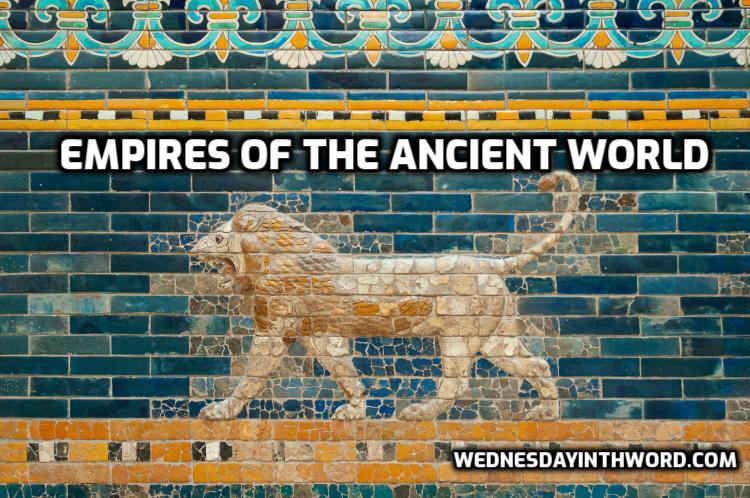Empires of the Ancient World
Over the course of biblical history, the children of Israel were challenged, threatened and conquered by several other ancient empires. Understanding something about those empires can inform your biblical understanding.
Ancient Egypt
The first third of the book of Exodus takes place in Egypt. The Israelites lived in Egypt for 400 years and were steeped in Egyptian culture. The cultural and historical setting of Exodus is ancient Egypt.
- Egypt developed a civilization early around 3000-2800 BC.
- Old Kingdom 2575-2150 BC
- First Intermediate Period 2125-1975 BC
- Middle Kingdom 1975-1640 BC
- Second Intermediate Period & Hyksos invasion 1630-1520 BC
- New Kingdom 1539-1075 BC
- See Introduction to Ancient Egypt
- When did the Exodus happen?
Maps
- BibleHistory.com: Egypt in Bible Times.
- Map of Ancient Egypt.
- Ancient Egypt online: Maps
- Ancient Egypt online: Nile River
- Holman Bible Atlas: Egypt: Land of Bondage
- Holman Bible Atlas: Modern States and the Ancient Near East
- Holman Bible Atlas: Ancient Near East
- Holman Bible AtlaS: Geography and Trade Routes of the Middle East
Assyrian Empire 740-612 BC
The Assyrian Empire is important to biblical history for devastation the kingdom of Israel and taking the 10 northern tribes into captivity in 722 BC.
The Assyrian Empire began to arise around 1270 BC, in the area far north on the Tigris River after the fall of Chaldea. The first capital of Assyria was Assur. Nimrod was the capital of ancient Assyria. Then Nineveh became capital, during the reign of king Sennacherib. Nineveh soon became one of the largest cities of the ancient Near East. At the height the Assyrian Empire the kingdom embraced the lands of the northern Tigris, Armenia, Media, Babylonia, Elam, Mesopotamia, Syria, Israel, Judah, and the northern portion of Egypt. The city of Nineveh was finally destroyed by the Medes and Babylonians in 625 BC.
- Kings of Assyria in Biblical Times
- Wikipedia: Assyria
- Wikipedia: List of Assyrian Kings (scroll down to Neo Assyrian Kings)
- Bible Atlas: Assyria
- Bible Atlas: Nineveh
- Bible Atlas: Samaria
- Chronology of Ezra-Nehemiah
- 1906 Jewish Encyclopedia: Tiglath-Pileser
- American Tract Society Dictionary: Tiglath-Pileser
- Bridgeway Bible Dictionary: ..
- Easton’s Bible Dictionary: Tiglath-Pileser III.
- Fausset Bible Dictionary: Tiglath Pileser
- Holman Bible Dictionary: Tiglath-Pileser
- Hastings’ Dictionary of the Bible: Tiglath-Pileser
- Kitto’s Popular Cyclopedia of Biblical Literature: Tiglath-Pileser
- Morrish Bible Dictionary: Tiglathpileser, Tilgathpilneser
- International Standard Bible Encyclopedia: Tiglath-Pileser
- McClintock and Strong: Tiglath-Pileser
Maps – Holman Bible Atlas
- The Rise of Assyria
- Israel & Judah in the days of Jeroboam II and Uzziah
- The Assyrian Empire under Tiglath-Pileser III
- The Syro-Ephraimite War
- Tiglath-Pileser III’s Campaigns
- Fall of Samaria and Deportation of Israelites
- The Fall of the Kingdom of Israel
- Assyrian Districts after the Fall of Samaria
- Assyria in the 7thC BC
Maps Insight for Living
Babylonian Empire 612-539 BC
The Babylonian Empire (also called the Chaldean Empire) became a world power in 625 BC after the fall of Assyria. Babylon continued its reign until 536 BC. Nebuchadnezzar, its greatest king, reigned in the days of Daniel and took the southern Kingdom of Judah into captivity after the fall of Jerusalem in 586 BC. Babylon was finally captured by the Medes and Persians under Cyrus as predicted by the prophet Daniel, and the Babylonian Empire came to an end in 536 BC.
- Kings of Babylon in Biblical Times
- Bible Atlas: Babylon
- Who was Nebuchadnezzar?
- BibleStudyTools.com: Nebuchadnezzar
- Wikipedia: Babylonia
- Wikipedia: Nebuchadnezzar II
- Wikpedia: List of the Kings of Babylon
- Encyclopedia Britannica: Nebuchadnezzar
- Ancient History Encyclopedia: Nebuchadnezzar
- 1906 Jewish Encyclopedia: Nebuchadnezzar
- American Tract Society Dictionary: Nebuchadnezzar
- Bridgeway Bible Dictionary: Nebuchadnezzar
- Easton’s Bible Dictionary: Nebuchadnezzar
- Fausset Bible Dictionary: Nebuchadnezzar
- Holman Bible Dictionary: Nebuchadnezzar
- Hastings’ Dictionary of the Bible: Nebuchadnezzar
- Kitto’s Popular Cyclopedia of Biblical Literature: Nebuchadnezzar
- Morrish Bible Dictionary: Nebuchadnezzar, or Nebuchadrezzar
- International Standard Bible Encyclopedia: Nebuchadnezzar; Nebuchadrezzar
- McClintock and Strong: Nebuchadnezzar
Maps – Holman Bible Atlas
- The Rise of the Neo-Babylonian Empire
- Nebuchadnezzar’s Campaigns against Judah
- Judah during the Exile
- The Kingdom of Judah
- Exile; Palestine in the Post-Exilic Period
- Jewish Exiles in Babylon
- Jewish Refugees in Egypt
Medo-Persian Empire 539-331 BC
The Persian Empire was founded by Cyrus the Great who conquered Babylon in 536 BC. Cyrus issued the decree for the Jews to return to Jerusalem and rebuild the temple. Under Darius the second Temple of Zerubbabel was completed; and under Xerxes, or Ahasuerus, the events recorded in the Book of Esther in the Bible happened; under Artaxerxes the Jewish state was reformed by Ezra, and the walls of Jerusalem were rebuilt by Nehemiah. The capital of the Persian Empire was Shushan. The Empire lasted a little more than 200 years, and came to an end in 330 BC.
- Kings of Persia in biblical times
- Chronology of Ezra-Nehemiah
- Wikipedia: Achaemenid Empire (aka Old Persia)
- Wikipedia: List of the Kings of Persia
- Bible Atlas: Persia
- Encyclopedia Britannica: Cyrus the Great
- Ancient History Encyclopedia: Cyrus the Great
- 1906 Jewish Encyclopedia: Cyrus the Great
- American Tract Society Dictionary: Cyrus
- Bridgeway Bible Dictionary: Cyrus
- Easton’s Bible Dictionary: Cyrus
- Fausset Bible Dictionary: Cyrus
- Holman Bible Dictionary: Cyrus
- Hastings’ Dictionary of the Bible: Cyrus
- Kitto’s Popular Cyclopedia of Biblical Literature: Cyrus
- Morrish Bible Dictionary: Cyrus
- International Standard Bible Encyclopedia: Cyrus
- McClintock and Strong: Cyrus; Cyrus (2)
Maps – Holman Bible Atlas
- World Powers of the 6th century BCE
- The Conquests of Cyrus the Great
- The Persian Empire
- The Return of the Jewish Exiles to Judah
- Judah in the 5th century BCE
- Palestine after the Exile
Macedonian Empire 330-323 BC
Persian rule was ended by Alexander the Great who “conquered the world” (England to India) at age 25 in 334 BC. Alexander the Great died in 323 BC and left no successor, plunging the empire into a bloody civil war which eventually settled into 4 main kingdoms ruled by: Seleucus (Asia), Ptolemy (Egypt), Lysimachus (Thrace), and Antipater’s son Cassander (Macedonia, including Greece).
See: Introduction to the Intertestamental period
- Wikipedia: Macedonian Empire
- Wikiepedia: History of Macedonia
- Bible Atlas: Macedonia
Maps from Holman Bible Atlas
- Alexander the Great’s Empire
- The Division of Alexander’s Empire ca. 275 BCE
- Palestine under the Ptolemies
- The Seleucid Empire and Antiochus III
- Campaigns of Antiochus IV against Egypt
- The Maccabees in 168 BCE
- Selected Events in the Maccabean Revolt
- Jewish Expansion under the Hasmonean Dynasty
- Pompey’s Campaign against Jerusalem
Roman Empire 246 BC – 476 AD
The Roman army under Pompey conquered the Seleucid empire in 63 BC and took control of Palestine, occupying Jerusalem.The Romans appointed Herod the Great as King over the Jews in 40 BC. His sons are the ones we read about in the New Testament.
More: New Testament History from Alexander to Titus
- Wikipedia: Roman Empire
- Wikipedia: History of the Roman Empire
- Wikipedia: List of Roman Emperors
- Timeline of the History of Macedonia
- Bible Atlas: Rome
Photo by Corbin Mathias on Unsplash

